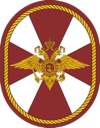Spetsnaz, are special forces in many post-Soviet states. Historically, this term referred to the Soviet Union's Spetsnaz GRU, special operations units of the GRU, the main military intelligence service. Today it refers to special forces branches and task forces subordinate to ministries including defence, internal affairs, or emergency situations in countries that have inherited their special purpose units from the now-defunct Soviet security agencies.

The Separate Operational Purpose Division or ODON, formerly called OMSDON, is a rapid deployment internal security division of the Internal Troops of the Ministry of Internal Affairs of the USSR and then the Russian Federation, currently part of the National Guard Forces Command of the Russian Federation. ODON is an initialism for Отдельная дивизия оперативного назначения.

Militsiya were the police forces in the Soviet Union until 1991, in several Eastern Bloc countries (1945–1992), and in the non-aligned SFR Yugoslavia (1945–1992). The term Militsiya continues to be used in common and sometimes official usage in some of the individual former Soviet republics such as Belarus, Tajikistan, Uzbekistan and Kyrgyzstan, as well as in the partially recognised or unrecognised republics of Abkhazia, South Ossetia, Transnistria, DNR and LNR.

OMON is a system of special police units within the National Guard of Russia. It previously operated within the structures of the Soviet and Russian Ministries of Internal Affairs (MVD). Originating as the special forces unit of the Soviet Militsiya in 1988, it has played major roles in several armed conflicts during and following the 1991 dissolution of the Soviet Union.

The Ministry of Internal Affairs of Belarus, abbreviated МUS (МУС) in Belarusian and MVD (МВД) in Russian, is a body of the Belarusian Government that is charged with the internal affairs of Belarus. Day to day law enforcement is carried out by the Militsiya. The Ministry is also tasked with providing security to state buildings and officials. Organizations such as the Presidential Guard are under the control of the Ministry. The clearing of landmines is among the tasks of the ministry.

Internal troops, sometimes alternatively translated as interior troops or interior ministry forces, are military or paramilitary, gendarmerie-like law enforcement services, which are found mostly in the post-Soviet states, primarily Russia. Internal troops are subordinated to the interior minister of their respective countries.

The Internal Troops of Ukraine, abbreviated ВВ (VV), were a uniformed gendarmerie and Internal Troops in Ukraine which merged with the National Guard of Ukraine on March 13, 2014. They were subordinate to the Chief Directorate of Ministry of Internal Affairs, and cooperate with the State Emergency Service of Ukraine. The VV were used to assist militsiya in policing, deal with riots and internal armed conflicts, and safeguard important facilities such as nuclear power plants. In wartime, the Internal Troops were under the jurisdiction of the Ukrainian armed forces for local defense and rear area security.
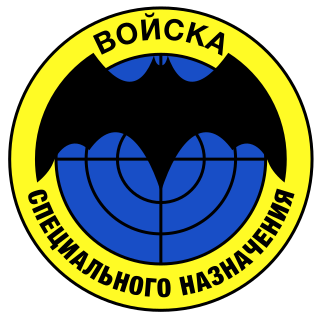
Spetsnaz GRU, formally known as Special Forces of the Main Directorate of the General Staff of the Russian Armed Forces, is the special forces (spetsnaz) of the GRU, the foreign military intelligence agency of the Armed Forces of the Russian Federation.

The Armed Forces of the Pridnestrovian Moldavian Republic are the military forces of the unrecognized state of Transnistria. The Armed Forces fall under the leadership of the Ministry of Defence. The Armed Forces were created on 6 September 1991 to maintain the sovereignty and independence of the Pridnestrovian Moldavian Republic, in accordance with Article 11 of the Republic's Constitution.
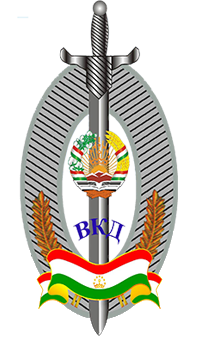
The Tajik Internal Troops are the internal security force of Tajikistan, under the Interior Ministry (VKD). They act as the primary reserve force of the Tajik Armed Forces, and are in charge of homeland defence, along with the Tajik Border Troops. The Internal Troops are led by Major General Negmatullo Kurbanov.

The National Guard Forces Command of the Russian Federation is the operational gendarmerie component of the National Guard of Russia, created through a presidential decree on April 5, 2016. Functionally, it is a gendarmerie organized along paramilitary lines with a mission to ensure public order, national security and defense against terrorism. To this end, Forces Command handles the operational units of the National Guard, including its rapid deployment branch, the Separate Operational Purpose Division (ODON); and its naval branch, the National Guard Naval Service Corps.

The Ministry of Internal Affairs of Kyrgyzstan is a Government ministry that is connected to the Armed Forces of the Kyrgyz Republic. The organization also commands the Kyrgyz Frontier Force and administers the MVD Academy of Kyrgyzstan.

The Ministry of Internal Affairs of the Republic of Kazakhstan is the Kazakh government ministry which oversees the police and the National Guard of Kazakhstan. The Ministry is headed by the Minister of Internal Affairs of the Republic of Kazakhstan, appointed by the decree of the President of Kazakhstan. The Minister of Internal Affairs has 5 deputies, including the First Deputy Minister.
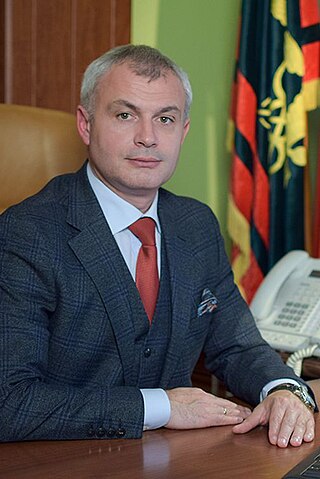
The Ministry of Internal Affairs of Transnistria also known as the Ministry of the Interior is an official government agency of the partially recognized Pridnestrovian Moldavian Republic. It is the executive body in implementing defense policies in of the Armed Forces of Transnistria. It is the successor to the Soviet Department of Internal Affairs Pridnestrovian Moldavian Soviet Socialist Republic (PMSSR) The current Minister of Internal Affairs is Major General Vitaly Neagu.

The Academy of the Ministry of Internal Affairs of the Kyrgyz Republic named after Ergesh Aliyev, known locally as the MVD Academy of Kyrgyzstan is a military institution in the Armed Forces of the Kyrgyz Republic acts as a training center for future soldiers and officers of the Internal Troops and future police officers in the Ministry of Internal Affairs. It is named after Police Major General Ergesh Aliyev, who was the first high ranking officer in the original Kyrgyz Militia.

The 604th Red Banner Special Purpose Centre "Vityaz" is a special forces unit of the National Guard of Russia.

The Internal Troops of the Ministry of Internal Affairs is an Internal Troops - paramilitary law enforcement force in the Republic of Belarus under the national Ministry of Internal Affairs. All personnel are trained in the Internal Troops Faculty of the Military Academy of Belarus.

The 6th Separate Special-Police Brigade of the Internal Troops of Belarus, officially known as Military Unit 5525, is a special police formation of the Internal Troops of Belarus under Ministry of Internal Affairs. Its forces are deployed in four cities of the Gomel Oblast: Gomel, Mazyr, Rechytsa and Svietlahorsk. By 2015, the unit carried out almost the entire range of tasks assigned to the Internal Troops; it was staffed by 2/3 with contract servicemen, warrant officers and officers.

The Central Orsha-Khingan Order of Zhukov Red Banner National Guard District is a regional district of the National Guard Forces Command, National Guard of Russia. It is headquartered in Moscow and under the command of Colonel General Aleksandr Popov. General Popov was appointed to the post by a Ukaz of 30 July 2021.
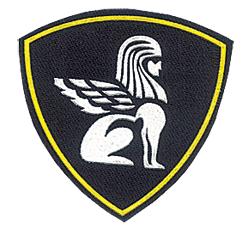
The Northwestern Order of the Red Star National Guard District is a district of the National Guard Forces Command of the Russian Federation.











